|
Posted 4/1/25
GUN CONTROL? WHAT’S THAT?
Ideological quarrels beset gun laws.
And gun law-making. And gun law-enforcing.

For Police Issues by Julius (Jay) Wachtel. Yes, that’s a judge. And not just any jurist. Judge Lawrence VanDyke sits on the august Ninth Circuit Court of Appeals. Based in San Francisco, it’s the nation’s largest Federal appellate court, with twenty-nine judges covering nine Western states, Guam, Hawaii and the Northern Mariana Islands.
Yes, that’s a pistol in his hands. Not just any pistol. It’s the judge’s very own Sig P-320 Compact. And he added a feature of which he’s very proud. He talks about it on his very own YouTube video:
Click here for the complete collection of gun control essays
…My own self-defense handgun…another P-320…has a red-dot object precisely because it makes the firearm better for its intended purpose; that is, self-defense. It makes it more accurate, more crispy, and shoot more quickly.
 Check out this picture. Judge VanDyke is gesturing to a “red dot sight.” Installed in front of the regular rear sight, the red dot version features an aiming screen with a floating red dot that falls precisely on the spot where a gunshot would strike. (No beam gets projected – everything happens within the sight.) Here, the judge uses the gadget to exemplify an accessory that, depending on a gun user’s skill and proclivities, can either help or hurt: Check out this picture. Judge VanDyke is gesturing to a “red dot sight.” Installed in front of the regular rear sight, the red dot version features an aiming screen with a floating red dot that falls precisely on the spot where a gunshot would strike. (No beam gets projected – everything happens within the sight.) Here, the judge uses the gadget to exemplify an accessory that, depending on a gun user’s skill and proclivities, can either help or hurt:
Now, in that sense, this red-dot object is just like this magazine [gestures to a high-capacity pistol magazine]. It would make the firearm more dangerous when it’s misused, but it also makes the firearm work better for its intended purpose when it’s used properly…
At the time, Judge VanDyke was part of an en banc panel. Eleven of the Circuit’s twenty-nine justices had been assigned to review California’s appeal of a Federal District Court decision that declared the state’s ban on high-capacity ammunition magazines unconstitutional (Virginia Duncan, et. al. v. Rob Bonta, no. 23-55805.) Judge VanDyke, who happened to agree with the ruling, knew that his philosophical leanings inevitably consigned him to the losing team. Still, he took the perhaps unprecedented step of starring in that video to bolster his dissent.
Alas, it failed to impress his colleagues. And also clearly irritated a few. Here’s a slice of Judge Susan Graber’s reaction:
Judge VanDyke himself appears in the recorded presentation making factual assertions about how guns work and providing physical demonstrations to support his assertions. By doing so, Judge VanDyke casts himself in the role of an expert witness, speaking to the type of “technical” and “specialized” issues that are reserved for witnesses properly “qualified as an expert.”
On March 20, 2025, the panel ruled 7-4, with Judge VanDyke in the minority, that California’s prohibition of ammunition magazines that can hold more than ten rounds, which had been in effect since 2017, was indeed consistent with the Second Amendment. According to Judge Graber, who wrote the majority opinion, “large-capacity magazines are neither ‘arms’ nor protected accessories.” And even if they were, California’s ban comported with the Supreme Court’s Bruen decision, as it “falls within the Nation’s tradition of protecting innocent persons by prohibiting especially dangerous uses of weapons and by regulating components necessary to the firing of a firearm” (emphasis ours.)
Judge Graber’s support of the notion that States can restrict so-called “necessary” gun components really set off Judge VanDyke. After all, if California can prohibit certain magazines, is anything off the table?
Under the majority’s rationale, any magazine that holds more than one round is not “necessary” for the function of the weapon. So presumably California could also ban magazines holding five rounds. Maybe even two…under that logic, basically every part of a firearm is an “optional component” because each could be replaced with a less effective (aka, less “dangerous”) version of that part and the firearm would still “operate” in some sense.
Worse still, might gun controllers go after his beloved red dot sights? After all, sights are “necessary.”
Full stop. Scroll through the opinion. Including arguments pro- and con-, it runs a stunning one-hundred-forty-seven pages. (Judge’s clerks must have been really busy!) But relax. We don’t intend to opinionate on what’s a “necessary” gun component, nor whether it really matters. Instead, let’s use the Court’s official seniority list to see how the judges’ views aligned politically:

Had the Ninth Circuit’s finest set out to craft deeply-considered legal analyses, irrespective of whose ox might be gored? We’d like to think so, but the table literally screams…NOT!
Was all that profound (and ostensibly impartial) opinionating a ruse?
This wasn’t the panel’s first time on the issue. San Diego U.S. District Judge Roger Benitez, a Bush appointee with a reputation as a fierce pro-gun advocate, had twice overturned California’s ban, in 2019 and 2023. His first foray was stayed by a nearly-identical Circuit Court panel. (Its only difference was that Obama appointee Paul J. Watford, who since retired, then held the spot that his replacement, Clinton nominee Kim Wardlaw, now holds.) And yes, the vote had also been 7-4, with “Blues” in the majority.
 It’s no secret that judicial opinions align with their authors’ sociopolitical leanings across all Court levels. Three years ago, in “Judicial Detachment: Myth or Reality,” we used M-Q scores to assess the ideological preferences of…the Supremes! Over the long term, Justices Thomas and Alito were consistently the “reddest.” Their preferences apparently still hold true. In a recent decision (Bondi v. Vanderstock, no. 23-852, decided 3/26/25) the Supreme Court ruled, 7-2, that parts kits used to assemble so-called “ghost guns” are themselves “firearms,” thus subject to all the regulatory provisions of the Gun Control Act. It’s no secret that judicial opinions align with their authors’ sociopolitical leanings across all Court levels. Three years ago, in “Judicial Detachment: Myth or Reality,” we used M-Q scores to assess the ideological preferences of…the Supremes! Over the long term, Justices Thomas and Alito were consistently the “reddest.” Their preferences apparently still hold true. In a recent decision (Bondi v. Vanderstock, no. 23-852, decided 3/26/25) the Supreme Court ruled, 7-2, that parts kits used to assemble so-called “ghost guns” are themselves “firearms,” thus subject to all the regulatory provisions of the Gun Control Act.
Who dissented? Justices Thomas and Alito.
Despite Vanderstock’s split verdict, the decision came as a relief to the anti-gun crowd. As of late, the high court hadn’t seemed favorably disposed to gun control. In June, 2022 their highly consequential Bruen decision found New York State’s requirement that CCW applicants show “a special need for self-protection” inconsistent with the “Nation’s historical tradition of firearm regulation” and unsupported by the “plain text” of the Second Amendment. Not-so-incidentally, the Court’s 9-3 split aligned perfectly with the Justices’ M-Q scores. Justice Thomas, the “reddest” member of the Court, delivered the majority opinion, while each dissenter – Justices Kagan, Breyer and Sotomayor – sat at the opposite, “blue” extreme.
Justice Breyer retired. His replacement, Justice Ketanji Brown Jackson, has apparently filled his ideological space as well. According to a recent academic analysis, her votes during the Court’s 2023 term consistently aligned with those of Justice Breyer’s old “pals,” Kagan and Sotomayor.
Gun-related struggles also pervade the Circuits. Consider the run-up to the Supreme Court’s parts kits decision. Texas Federal District Judge Reed O'Connor, a Bush appointee, is said to be “a ‘go-to’ favorite for conservative lawyers.” In November 2022 he ruled in a lawsuit filed by pro-gunners that ATF’s classification of gun part kits as “firearms” conflicted with the Second Amendment. And the reportedly モhard-rightヤ Fifth Circuit Court of Appeals agreed. Often sought out by gun control opponents, the Fifth has ruled against prohibitions on “bump stocks” and on gun possession by drug users and persons under domestic violence restraining orders. Its most recent thumbs-down was on the Federal laws that prohibit licensed dealers from selling handguns to persons under 21. In the words of Circuit Judge Edith H. Jones, “the text of the Second Amendment includes eighteen-to-twenty-year-old individuals among 'the people' whose right to keep and bear arms is protected.”
Shift to the Third Circuit. In 1995 Pennsylvania resident Bryan Range pled guilty to “making a false statement to obtain food stamps.” He drew probation. Nearly thirty years later Mr. Range sought to buy a gun. However, Federal law (18 USC 922[g][1]) precludes anyone who has been convicted of a crime “punishable by imprisonment for a term exceeding one year” from having guns. It applies to Mr. Range, as he could have drawn up to five years. But his offense was decidedly non-violent. Citing Bruen, on December 23, 2024 the Third Circuit ruled 13-2, en banc, that the Federal prohibition did not extend to such crimes:
Because Range and his proposed conduct are protected by the Second Amendment, we now ask whether the Government can strip him of his right to keep and bear arms. To answer that question, we must determine whether the Government has shown that applying § 922(g)(1) to Range would be “consistent with the Nation’s historical tradition of firearm regulation.” Id. at 24. We hold that the Government has not carried its burden.
How will ordinary folks know whether they’re covered by this exception? That’s what the dissenters want to know. How might Federal gun law enforcement be affected in the Circuit’s territory (Delaware, New Jersey, Pennsylvania, and the U.S. Virgin Islands)? That’s what we’d like to know.
Gun-friendly Attorneys General have also leaped into the fray. Most recently, the 11th. Circuit ruled that Florida law which prohibits persons under 21 from buying long guns – it was enacted after the Marjorie Stoneman High School massacre – is Constitutional. (Its decision was 8-4; each dissenter is a Trump appointee.) Even so, Florida Attorney General James Uthmeier, a notable “Red,” warned that his office wonメt defend the law should the thus-far-unsuccessful plaintiffs (the NRA) appeal to the Supremes: “Men and women old enough to fight and die for our country should be able to purchase firearms to defend themselves and their families.”
Concerns about the trampling of citizen’s gun rights aren’t only being expressed by State lawyers. Attorney General Pamela Bondi just announced that the Department of Justice has instituted a “patterns or practice” investigation of the Los Angeles County Sheriff’s Department. DOJ’s Civil Rights Division will probe whether the LASD has been “depriving ordinary, law-abiding Californians of their Second Amendment rights” by imposing unseemly delays on the issuance of CCW permits. According to DOJ, this problem seems commonplace in the (very “blue”) Golden State, where cities commonly impose “expensive fees and lengthy wait times” well beyond what’s called for.
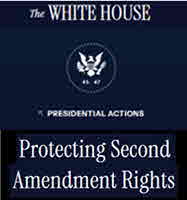 Like worries apparently extend to the White House. On February 27, 2025 President Trump issued Presidential Order “Protecting Second Amendment Rights.” It directs DOJ to review Federal laws and rules enacted between 2021-2025 that “may have impinged on the Second Amendment rights of law-abiding citizens.” Among those to be examined are ATF regulations that tightened dealer oversight, banned pistol braces and addressed “ghost guns.” Also in the bull’s-eye is the Federal “Bipartisan Safer Communities Act,” a 2022 law that among (many) other things, did away with loopholes that allowed some gun buyers bypass background checks. Like worries apparently extend to the White House. On February 27, 2025 President Trump issued Presidential Order “Protecting Second Amendment Rights.” It directs DOJ to review Federal laws and rules enacted between 2021-2025 that “may have impinged on the Second Amendment rights of law-abiding citizens.” Among those to be examined are ATF regulations that tightened dealer oversight, banned pistol braces and addressed “ghost guns.” Also in the bull’s-eye is the Federal “Bipartisan Safer Communities Act,” a 2022 law that among (many) other things, did away with loopholes that allowed some gun buyers bypass background checks.
Be sure to check out our homepage and sign up for our newsletter
ATF, the nation’s key gun law enforcement agency (and your writer’s past employer) is caught in a maelstrom. As he bemoaned budget cuts under the “blues,” Steven Dettelbach, the beset agency’s last regular Director, predicted that ATF’s finances could only get worse. He resigned in mid-January. Mr. Dettelbach hardly had a choice, as incoming President Trump had referred to him as an “anti-gun fanatic” at an NRA rally. Most recently, the Administration’s announcement of a plan to merge ATF with DEA has drawn great concern. Here’s what the Giffords gun control group had to say:
Cutting resources from the ATF would quite literally be defunding the police. The agency's mission is to stop violent gun crime and protect public safety. Merging it with another agency would reduce staffing and resources, weakening efforts to stop gun traffickers, straw purchasers, and rogue gun dealers.
Kash Patel, the outsider whom President Trump tapped to temporarily lead the FBI, was also tasked with overseeing ATF. But he seems “missing in action.” According to the Washington Post, his absence “is reflective of the uncertainty hovering over ATF, a relatively small law enforcement entity that has bubbled into a political juggernaut, touted by Democrats as critical to combating gun violence and accused by Republicans of trying to overregulate firearms.”
As for your writer, he’s still drawing his ATF pension. Which he naturally helped fund. As of yet, it’s unaffected.
UPDATES (scroll)
7/25/25 Ruling 2-1, a Ninth Circuit Court
of Appeals panel overturned California's requirement that ammunition buyers submit to a background check every time they cue up for their rounds. According to the panel, the law "meaningfully constrains the right to keep
operable arms" and is inconsistent with the historical tradition test imposed by the Supreme Court's Bruen decision.
7/3/25 California doesn’t recognize concealed-carry licenses issued by other States. Its laws also forbid non-residents from applying for a CCW permit. This, according to a Southern California Federal judge, is a bridge too far. Ruling in a lawsuit filed against the State’s A.G. by an out-of-state resident, U.S. District Judge Cathy Ann Bencivengo just found that California’s unforgiving posture violates the Second and Fourteenth Amendments. She has ordered that the parties “meet and confer and submit a proposed order for an injunction consistent with this order within 30 days.”
7/2/25 Overturning a lower-court decision, a three-judge panel of the Fourth Circuit Court of Appeals ruled that Federal law prohibiting the sale of handguns to persons under 21 “fits squarely within” the test imposed by Bruen, and is therefore Constitutional. “From English common law to America’s founding and beyond, our regulatory tradition has permitted restrictions on the sale of firearms to individuals under the age of 21.” However, this opinion clashes with a January ruling by the Fifth Circuit, so it will be ultimately up to the Supreme Court to decide. Decision
5/19/25 DOJ announced that “in accordance with President Trump’s Executive Order “Protecting Second Amendment Rights” it was abandoning litigation to ban “forced-reset” triggers (FRT’s). ATF had ruled that these drop-in gadgets, which enable firearms to mimic fully-automatic fire, are illegal machinegun conversion devices. But a Texas appellate court disagreed. DOJ’s agreement with Rare Breed Triggers allows FRT’s to be made and sold for use in long guns, not for pistols.
4/3/25 Elon Musk, owner of Tesla and director of the Administration’s DOGE program, reportedly spent $21 million to help former State A.G. Brad Schimel win the Wisconsin Supreme Court seat held by Susan Crawford. But although she was painted as “weak on crime,” Crawford, a “blue,” defeated Schimel, a staunch “red.” Crawford had drawn support from former President Obama and mega-rich financier George Soros. Her win cements a 4-3 “blue” majority on the State’s high court until 2028, when another “blue” justice will be up for re-election to a 10-year term. Their seats are supposedly non-partisan.
|
Did you enjoy this post? Be sure to explore the homepage and topical index!
Home Top Permalink Print/Save Feedback
RELATED POSTS
Who’s Under the Gun? ATF, That’s Whom Ideology (Still) Trumps Reason
Judicial Detachment: Myth or Reality? Ban the Damned Things! Reviving an Illusion
Posted 3/6/25
WHO’S UNDER THE GUN?
THE ATF, THAT’S WHOM
Going after gun controllers, for the usual reasons
For Police Issues by Julius (Jay) Wachtel. As bad as things may seem for the FBI (see its own “Under the Gun” post,) the highly-regarded law enforcement agency’s prospects have definitely not fallen to ATF’s level. While no Federal legislator proposes to do away with the “Feebs” altogether, thirty-three Representatives recently signed on to House Bill 221, the “Abolish the ATF Act.” Introduced by Rep. Eric Burlison (R-MO) on January 7th., its full text is presently comprised of a single, unambiguous sentence: “The Bureau of Alcohol, Tobacco, Firearms and Explosives is hereby abolished.” Natch, in our ideologically-split land, it’s no surprise that Rep. Burlison and each of his co-conspirators (oops, we meant co-signers) are “Reds.”
But if ATF can’t simply be booted out, Rep. Tracey Mann (R-KS) has proposed a measure that would in effect achieve the same purpose. Modeled after lawsuits filed by the Gun Owners of America (click here and here,) House Bill 624, the RIFLE Act (“Reining In Federal Licensing Enforcement”) is a re-play of a measure that Rep. Mann introduced during the last term (graphic on the left.) Zeroing in on that noxious, “zero-tolerance” regulatory approach over firearms dealers that was imposed by the recently-toppled “Blue” regime, his proposal narrowly defines “willful” (i.e., purposeful) misconduct, which can strip dealers of their licenses and even lead to prosecution. Multiple instances of flawed record-keeping would normally be treated as a single event. What’s more, even when missteps seem intentional, licensees would usually have to be given an opportunity to mend their ways. And if those nasty Feds still insisted on taking their license, dealers would get elaborate hearings before administrative law judges – in effect, mini-trials – where the Government would have to prove two things: that a violation was committed “willfully,” and that letting the dealer stay in business “poses an immediate and grave threat to public safety.”
So there!
Click here for the complete collection of gun control essays
Twenty-eight House members affixed their John Hancocks as co-signers to Rep. Mann’s bill. Again, all are “Reds.” Many have also introduced their own gun-related measures during the present term. Here’s a look at a few:
1. Repeal the NFA Act (H.R.335): Rep. Burlison (of “Abolish ATF” fame) also presented a bill to repeal the National Firearms Act, a long-established Federal law that imposes fees and strict conditions on the manufacture, possession and transfer of machineguns and other restricted weapons. He’s particularly incensed that pistols with mere “stabilizing braces” are being treated as killer short-barreled rifles.
2. ATF Accountability Act of 2025 (H.R.607): Rep. Dan Crenshaw (R-TX) would institute a 90-day time limit for the Attorney General to rule on challenges to gun regulatory decisions. Equally timely decisions by administrative law judges are also part of the mix.
 3. Define silencers as an ordinary gun accessory (S.364, H.R.850, S.345, H.R.631): Senators Mike Crapo (R-ID) and Mike Lee (R-UT) and Reps. Michael Cloud (R-TX) and August Pflueger (R-TX) believe that the hearing protection assertedly afforded by silencers warrants their removal from the special fees and registration requirements presently imposed by Federal law. 3. Define silencers as an ordinary gun accessory (S.364, H.R.850, S.345, H.R.631): Senators Mike Crapo (R-ID) and Mike Lee (R-UT) and Reps. Michael Cloud (R-TX) and August Pflueger (R-TX) believe that the hearing protection assertedly afforded by silencers warrants their removal from the special fees and registration requirements presently imposed by Federal law.
4. Prohibit States and localities from superseding Federal gun laws (H.R.373): Rep. Claudia Tenney (R-NY) proposes to prohibit States and cities from outlawing the possession of firearms that are legal under Federal law. Say, New York State, which has supposedly trampled on the Second Amendment by outlawing high-capacity magazines and guns with “military-style” features.
5. Transparency Act (H.R.613): Rep. Russ Fulcher (R-ID) would impose a 90-day time limit on criminal background checks for gun sales and transfers. And, as well, on the adjudication of appeals filed by would-be buyers who get turned down. If the Government can’t do it within this time-frame, sales are to be considered approved.
6. Eliminate the national firearms registry (H.R.563 and S.119): Rep. Michael Cloud (R-TX) and Sen. James Risch (R-ID) introduced legislation that authorizes gun makers, distributors and dealers to throw away their sales records when they go out of business. At present they must turn them over to ATF, which uses the documents to create a registry that enables law enforcement agencies to identify the last known purchaser of guns they seize on the street. All sales records in ATF’s possession would also have to be destroyed.
7. Merchant category codes (H.R.1181 and H.R.1224): Reps. Riley Moore (R-WV) and Andrew Ogles (R-TN) propose to do away with codes used by credit card companies that identify merchants as gun or ammunition dealers.
8. State and local insurance requirements (H.R.943): Rep. Ronny Jackson (R-TX) would prohibit States and localities from imposing firearms-related taxes or fees or requiring that gun owners carry liability insurance.
“Blues” also want to tinker with gun laws. As one would expect, their preferences run in the opposite, gun and gun dealer-unfriendly direction. Here are some of the measures they’ve introduced during the present session:
1. Prompt reporting of missing guns (H.R.1456): Rep. Sean Casten (D-IL) would require that lost or stolen guns “be reported to law enforcement authorities within 48 hours.” He has eighteen co-sponsors.
2. Prohibit persons under 21 from buying highly lethal firearms (S.597): Sen. Alex Padilla’s (D-CA) proposal would prohibit anyone under 21 from buying an assault weapon or high-capacity magazine. He’s also got 18 co-sponsors.
3. Improve gun storage to prevent theft (H.R.1097 and S.468): Rep. Bradley Schneider (D-IL) and Sen. Richard Durbin (D-IL) have introduced companion measures that require firearms licensees to provide highly secure storage, including alarms and cameras, to safeguard their inventories and records.
4. Authorize private lawsuits against makers or sellers of unserialized “ghost guns” and ghost gun parts (H.R.544): Rep. Ritchie Torres (D-NY) introduced a bill that would allow persons injured by unserialized guns, and their families, to sue their sellers and makers in Federal court.
5. Study gun trafficking along I-95’s “Iron Pipeline” (H.R.543): Rep. Torres also introduced a bill that directs ATF to report on the nature and source of guns that are “trafficked” (i.e., illegally redistributed) along the East Coast’s main North-South corridor, and to suggest ways to combat the problem.
6. Handgun Permit to Purchase Act (H.R.532 and S.123): Rep. Jamie Raskin (D-MD) and Sen Chris Van Hollen (D-MD) feel that Maryland’s handgun licensing law has proven effective in combatting gun crimes and suicides. They propose that the Federal government fund studies and implementations of such measures elsewhere.
 7. Re-establish the White House Office of Gun Violence Prevention (H.R.1307 and S.595): Rep. Maxwell Frost (D-FL) was behind legislation that created this office under Pres. Biden. It supposedly helped individuals and communities get funding and resources to combat gun violence. But the office was promptly shuttered by the new regime. He and Sen. Christopher Murphy (D-CT) want to bring it back. Rep. Frost has 115 co-sponsors; Sen. Murphy has seven. All are “Blues.” 7. Re-establish the White House Office of Gun Violence Prevention (H.R.1307 and S.595): Rep. Maxwell Frost (D-FL) was behind legislation that created this office under Pres. Biden. It supposedly helped individuals and communities get funding and resources to combat gun violence. But the office was promptly shuttered by the new regime. He and Sen. Christopher Murphy (D-CT) want to bring it back. Rep. Frost has 115 co-sponsors; Sen. Murphy has seven. All are “Blues.”
What’s our take? None of the proposals we’ve examined, whether “Red” or “Blue,” focuses on an issue dear to our heart: licensee misconduct. Your writer spent the last few years of his career as an ATF special agent leading a gun trafficking group in Los Angeles. That’s where he discovered that misbehavior by firearms dealers is a major source of the killer guns that wind up on the street. His post-retirement journal article, “Sources of Crime Guns in Los Angeles, California,” examined (among many other things) twenty-eight gun diversion investigations conducted by L.A.-area ATF agents during 1992-1995. These addressed the diversion of 19,145 guns. Seventy-one percent (13,667) had gone through the hands of fifteen licensed dealers who falsified sales records or kept none at all. (For an instance with a particularly tragic outcome, check out “The Pistol That Killed Officer Heim.”)
“Following the Gun,” a landmark 2000 ATF study, confirmed that misconduct by Federal firearms licensees (FFL’s) was indeed a major problem:
Although FFL traffickers were involved in the smallest proportion of ATF trafficking investigations, under 10 percent, FFL traffickers were associated with by far the highest mean number of illegally diverted firearms per investigation, over 350, and the largest total number of illegally diverted firearms, as compared to the other trafficking channels.
Alas, the agency’s vigor for pursuing misbehaving licensees has long been in question. In May 2021 The Trace and USA Today released a deeply-researched analysis of “nearly 2,000” gun dealer inspections during 2015-2017 that led to a penalty, from a warning letter to a (rare) license revocation. It concluded that even licensees who “repeatedly” broke the rules were usually treated with a light touch, thus allowing them to continue their (highly consequential) predations:
The reports showed some dealers outright flouting the rules, selling weapons to convicted felons and domestic abusers, lying to investigators and fudging records to mask their unlawful conduct. In many cases when the ATF caught dealers breaking the law, the agency issued warnings, sometimes repeatedly, and allowed the stores to operate for months or years. Others are still selling guns to this day.
In June 2021 (only a month after that uncomplimentary assessment) the Biden administration announced a measure to cut down on gun crime. Its “Comprehensive Strategy to Prevent and Respond to Gun Crime and Ensure Public Safety” promised to address gun violence “by taking immediate steps to keep guns out of the wrong hands.” (It’s been removed from the White House website, so we downloaded it from the Wayback Machine. Click here for the whole thing, and here for BJA’s summary, which so far remains online.)
A month after President Biden issued his plan, ATF announced its now-notorious “zero-tolerance” policy for gun dealer misconduct. Here’s an extract:
Absent extraordinary circumstances, an inspection that results in a finding that an FFL has willfully committed any of the following violations shall [emphasis ours] result in a revocation recommendation: (a) The transfer of a firearm to a prohibited person; (b) Failing to conduct a required background check; (c) Falsification of records, such as a firearms transaction form; (d) Failing to respond to an ATF tracing request; (e) Refusing to permit ATF to conduct an inspection in violation of the law.
Problems with gun dealers nonetheless persisted. ATF’s most recent inspections “fact sheet” indicates that inspectors visited the premises of 8,689 firearms licensees in FY 2023. That was about six and one-half percent of the 132,383 licensees who were then in business. Reports of violation were completed for 1,531. “Warning letters” were issued to 667, “warning conferences” were held for 166, and 170 licenses were revoked.
Full stop. As one would expect, ATF’s aggressive posture drew major blowback from gun enthusiasts and the firearms industry. Here’s an outtake from the NRA’s recent parting shot at former ATF Director Steve Dettelbach (he resigned when President Trump came in for round #2):
Perhaps worst of all was the war on gun stores under Dettelbach’s “leadership.” In short, an executive order from Biden directed Dettelbach’s ATF to make life as difficult as possible for firearms dealers. This was done by implementing a “zero-tolerance policy,” which may have punished the “rogue,” “dishonest” gun dealers Biden claimed to be after, but also unfairly penalized law-abiding dealers for simple paperwork errors. As a result, the number of federal firearm licensees decreased by more than 1,600 since Biden took office.
In August 2024, ATF issued a lengthy directive to its inspectors reminding them that “not every repeat violation is per se willful.” It also sets out, in mind-numbing detail, the circumstances that must be present to justify a revocation. According to gun-skeptical The Trace, these “adjustments” actually proved minor and only led to a “slight” reduction in revocations.
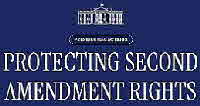 ATF ’s failure to scrap its “zero-tolerance” approach got its ultimate comeuppance on February 7, 2025. That’s when President Trump issued Executive Order “Protecting Second Amendment Rights.” This Order, which is on the White House website, commands the Attorney General to devise a “plan of action” that would “protect the Second Amendment rights of all Americans.” Probes are required in three key areas: ATF ’s failure to scrap its “zero-tolerance” approach got its ultimate comeuppance on February 7, 2025. That’s when President Trump issued Executive Order “Protecting Second Amendment Rights.” This Order, which is on the White House website, commands the Attorney General to devise a “plan of action” that would “protect the Second Amendment rights of all Americans.” Probes are required in three key areas:
(i) All Presidential and agencies’ actions from January 2021 through January 2025 that purport to promote safety but may have impinged on the Second Amendment rights of law-abiding citizens;
(ii) Rules promulgated by the Department of Justice, including by the Bureau of Alcohol, Tobacco, Firearms, and Explosives, from January 2021 through January 2025 pertaining to firearms and/or Federal firearms licensees;
(iii) Agencies’ plans, orders, and actions regarding the so-called “enhanced regulatory enforcement policy” pertaining to firearms and/or Federal firearms licensees…
Be sure to check out our homepage and sign up for our newsletter
And now, of course, there’s newly-confirmed FBI Director Kash Patel. He was given ATF’s reins as well. Portrayed by The Trace as “cozy with the most extreme flank of the gun rights movement,” Mr. Patel has reportedly suggested abolishing ATF altogether. One-time Secret Service agent Dan Bongino, a notoriously “Red” podcaster whom Mr. Patel brought in as his deputy, has expressed deep hostility towards the FBI. He also once posted on X that “the Second Amendment was NOT a suggestion.”
On the positive side, ATF’s core mission – combatting violent crime – continues to draw favorable attention, and even from its purported critics. Consider Ed Martin, whom President Trump recently appointed as D.C.’s acting U.S. Attorney. To “make D.C. safe again” he announced a campaign to prosecute gun-toting felons on Federal charges, and got a dozen extra ATF agents to help. In the recent past Mr. Martin openly criticized the Capitol riot cases as needless distractions from the fight against violence, and he seems to be an Administration favorite. So maybe there is hope for ATF.
Now, if we could only be sure that Elon Musk won’t try to rescind retired agents’ pensions...
UPDATES (scroll)
6/25/25 “Guns and drugs go together.” That, according to Attorney General Pamela Bondi, is why it makes sense to abolish ATF and assign its functions to DEA. Her plan, which is part of DOJ’s 2026 proposed budget, would need Congressional approval. But gun-control groups (and a few members of Congress) worry that, given the budget cuts already planned for ATF, a merger would further weaken oversight of the gun industry. Even some gun enthusiasts are opposed, but for the opposite reason. A merger, they fear, would create “a taxpayer-funded super agency to target gun owners.”
6/20/25 “This budget would be a win for unscrupulous gun dealers and a terrible setback for A.T.F.’s state and local law enforcement partners.” That’s the reaction of the president of a gun-safety group to DOJ’s FY 2026 (Oct. 2025-Sept. 2026) budget request, recently posted online. It foregoes hiring new or replacement ATF special agents. It also eliminates the positions of 541 inspectors who license and oversee gun dealers, thus “reducing ATF’s capacity to regulate the firearms and explosives industries by approximately 40 percent.” Huge chunks of money will also be stripped from crime gun tracing and from operating costs. Meaning, among other things, no new cars and no transfers.
5/30/25 “To Promote Fairness, Consistency, and Public Safety” ATF formally announced that it was abandoning its “zero-tolerance” policy for gun dealer inspections. Licensees will no longer be automatically penalized “for simple mistakes such as, forgetting to put their license number on forms.” Instead, minor errors will be addressed with “education or warnings.” Automatic license revocations are also out. Instead, “investigators must evaluate whether continued operations pose a public-safety threat or contribute to violent crime, and whether the licensee demonstrates the ability to comply moving forward.” (See 4/9/25 update)
5/19/25 DOJ announced that “in accordance with President Trump’s Executive Order “Protecting Second Amendment Rights” it was abandoning litigation to ban “forced-reset” triggers (FRT’s). ATF had ruled that these drop-in gadgets, which enable firearms to mimic fully-automatic fire, are illegal machinegun conversion devices. But a Texas appellate court disagreed. DOJ’s agreement with Rare Breed Triggers allows FRT’s to be made and sold for use in long guns, not for pistols.
5/5/25 Last year ATF erected a photographic memorial entitled “The Faces of Gun Violence” at the entrance to its D.C. headquarters. It was comprised of “about 120” photographs depicting police officers who were shot and killed in the line of duty, and innocent citizens who lost their lives in one of America’s many domestic gun massacres. But the memorial has been taken down. Ditto, its online page. DOJ denies that the move was politically inspired. But the daughter of one of the (former) honorees thinks otherwise.
4/11/25 In another ominous sign for the beleaguered agency, the Trump administration forced ATF’s number two, long-serving special agent Marvin Richardson, to resign from his position as Deputy Director. He had occupied that slot for five years, and was Acting Director in 2021. No reason was given.
4/10/25 According to A.G. Pamela Bondi, the Biden administration “placed an undue burden on gun owners and vendors by targeting law-abiding citizens exercising their 2nd Amendment rights.” DOJ has accordingly formed a Second Amendment Task Force. Comprised of representatives from her office and a host of DOJ components, including ATF and the FBI, its mission will be to develop policies and legal approaches “to advance President Trump’s pro-gun agenda and protect gun owners from overreach.” Meanwhile, Kash Patel is no longer heading ATF. Its new acting Director is Dan Driscoll. He also has another job. He’s Secretary of the Army. DOJ memorandum
4/9/25 Proclaiming that “this Department of Justice believes that the 2nd. Amendment is not a second-class right,” Attorney General Pamela Bondi announced that ATF’s “zero-tolerance policy” for gun dealer misbehavior, which was instituted during the Biden administration, has been repealed. ATF inspectors will no longer be enforcing its supposedly excessively stringent guidelines. In addition, DOJ is revisiting ATF rules that forbid fitting so-called “stabilizing braces” to pistols, and which expanded the definition of being “engaged in the business” of dealing in guns, and thus requiring a Federal license. (See 5/30/25 update)
3/28/25 As part of its agenda to shrink government, the Administration is proposing to merge two law enforcement agencies with wildly disparate missions: ATF, which investigates gun trafficking, arsons and bombings, and DEA, which is focused on major drug crimes. Doing so, it’s claimed, could lead to “efficiencies in resources, case deconfliction, and regulatory efforts.” ATF’s gun-control mission, though, is politically fraught. And a major gun-control group has warned that a loss of resources would seriously impair its ability to combat firearms traffickers and corrupt gun dealers.
|
Did you enjoy this post? Be sure to explore the homepage and topical index!
Home Top Permalink Print/Save Feedback
RELATED GOVERNMENT REPORTS
DOJ audit of ATF’s process to oversee Federal Firearms licensees (2023)
RELATED ESSAYS AND ARTICLES
Sources of Crime Guns in Los Angeles, California The Pistol That Killed Officer Heim
RELATED POSTS
Gun Control? What’s That? Who’s Under the Gun? The FBI, That’s Whom Do Gun Laws Work?
Where Do They Come From? Long Live Gun Control
Posted 1/6/25
ALL IN THE FAMILY (PART II)
A decade after Part I, domestic killings remain commonplace
For Police Issues by Julius (Jay) Wachtel. West Valley City, Utah isn’t crime-free. But with 134,470 residents and five murders in 2023, the working-class suburb’s 2023 homicide rate of 3.7 per 100,000 pop. was less than half Salt Lake City’s 7.6. West Valley’s peaceful mien, though, took a heavy hit on December 17 when a critically wounded teen and five family members were found shot dead in their home. Officers found a handgun under the father’s body. It’s believed that the 42-year old man used the weapon to massacre his family, then commit suicide.
Our source of information about domestic shootings, the Gun Violence Archive, codes this episode a “family annihilation.” Alas, such tragedies are by no means rare. Here’s a few we recently came across while perusing news stories for our daily Police Issues updates:
Click here for the complete collection of gun control essays
- December 2024, Milpitas, Calif.: Prosperous places are hardly immune. In the tony Silicon Valley community of 80,000, a welfare check prompted by relatives led cops to discover the bodies of a middle-aged couple and their two children. As in West Valley, police found a gun – it was legally registered to the father – and concluded that he massacred his family, then committed suicide. Mom and Dad were going through a divorce. Dad, who reportedly had mental problems, had just bought the gun.
- October 2024, Tijeras, New Mexico: Family shooters aren’t always dads. Rural New Mexico deputies were called to a home where neighbors had heard gunfire. Inside they found an armed twenty-four year old who was unhurt but “covered in blood.” And in a nearby ravine they discovered the bodies of his mom, dad and 17-year old sister, whom the young man had admittedly shot dead. He used his mother’s legally-acquired gun. His motive was undisclosed, but he apparently had mental health issues.
- December 2024, Belen, New Mexico: Some shooters are mere teens. In a working class suburb of Albuquerque an “extremely intoxicated” 17-year old informed 9-1-1 that he had just massacred his family. He surrendered to deputies without incident. Inside the home they found the bodies of his mom, dad and two brothers, ages 14 and 16. Each had been shot dead, apparently with the handgun that was on the kitchen table.
- October 2024, Fall City, Washington: Youngsters regularly figure in family massacres. Consider the 15-year old who told 9-1-1 that his brother “just shot my whole family and committed suicide too.” Only problem is, the caller was the killer. He used his father’s pistol to murder both his parents and three siblings, ages 7, 9 and 13. Only his 11-year old sister survived, and that’s because, although wounded, she had managed to flee through a window. She told police that her brother “had recently gotten into 'a lot of trouble' for failing some tests at school.”
“Kids With Guns” focused on school shootings. While plentiful, their numbers are no match for the appalling frequency of the gunplay that besets American homes. A decade ago, our prior foray into domestic violence, “All in the Family” (Part I), focused on episodes where fathers slaughtered their families. We now take a more inclusive approach. Using Gun Violence Archive data, we selected all incidents of gun violence in 2023 across the 50 States (D.C. and territories excluded) that involved domestic violence, had a single assailant, and where one or more victims were wounded or killed. Here are the totals broken down by assailant age:

Here are the incidents coded by the Archive as a “family annihilation”:

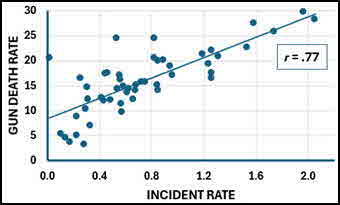 As this graph demonstrates, States (each is a “dot”) experienced markedly different outcomes. Still, their 2023 domestic violence incident rates tracked their 2023 gun death rates quite closely. States with low incident rates generally had low gun death rates, and those with higher incident rates suffered from elevated gun death rates. That relationship is reflected in the “r” (correlation) statistic. It ranges from zero, meaning no relationship between variables, to 1, which designates a perfect, lock-step relationship. Of course, accurate data reporting is a must. Check out Wyoming (top left dot.) Although its gun death rate was a substantial 20.6, it reported only one incident of gun-involved domestic violence in 2023. Removing Wyoming from the picture increased the overall r between incident rate and gun death rate to a substantial .82. As this graph demonstrates, States (each is a “dot”) experienced markedly different outcomes. Still, their 2023 domestic violence incident rates tracked their 2023 gun death rates quite closely. States with low incident rates generally had low gun death rates, and those with higher incident rates suffered from elevated gun death rates. That relationship is reflected in the “r” (correlation) statistic. It ranges from zero, meaning no relationship between variables, to 1, which designates a perfect, lock-step relationship. Of course, accurate data reporting is a must. Check out Wyoming (top left dot.) Although its gun death rate was a substantial 20.6, it reported only one incident of gun-involved domestic violence in 2023. Removing Wyoming from the picture increased the overall r between incident rate and gun death rate to a substantial .82.
What might lower the frequency of domestic violence incidents that involve gunplay? Fewer gun-owning households and stronger gun laws are two approaches.
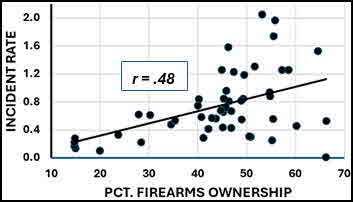 FAO - pct. household firearms ownership: We computed the correlation between 2023 state firearms ownership data from Rand and each State’s domestic violence incident rate. It produced a moderate r= .48. While they’re clearly not in lock-step, more guns are generally associated with more incidents of domestic firearms violence. Of course, accurate reporting is a must. Once again, note incident-less Wyoming at the lower right. Removing it from the calculation increased the overall “r” between FAO and the incident rate to a considerably heftier .56. FAO - pct. household firearms ownership: We computed the correlation between 2023 state firearms ownership data from Rand and each State’s domestic violence incident rate. It produced a moderate r= .48. While they’re clearly not in lock-step, more guns are generally associated with more incidents of domestic firearms violence. Of course, accurate reporting is a must. Once again, note incident-less Wyoming at the lower right. Removing it from the calculation increased the overall “r” between FAO and the incident rate to a considerably heftier .56.
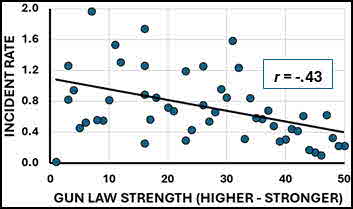 GLS - State gun law strength: Giffords’ State gun law strength scores (but with the order reversed so that 1 represents the State with the weakest gun laws and 50 the strongest) were correlated with State domestic violent incident rates. At r= -.43 the relationship is also only moderate (the r is negative, meaning that the variables move in opposite directions). As law strength goes up, incidents decrease; again, not in lockstep. However, pulling out incident-less Wyoming (lower left) strengthened the correlation to a more respectable r= -.51. GLS - State gun law strength: Giffords’ State gun law strength scores (but with the order reversed so that 1 represents the State with the weakest gun laws and 50 the strongest) were correlated with State domestic violent incident rates. At r= -.43 the relationship is also only moderate (the r is negative, meaning that the variables move in opposite directions). As law strength goes up, incidents decrease; again, not in lockstep. However, pulling out incident-less Wyoming (lower left) strengthened the correlation to a more respectable r= -.51.
 Tinkering with gun ownership and gun laws might also be useful for other purposes. State gun death rates, which are available through CDC Wonder, include suicides. In 2022, the most recent year for which data is available, over half of suicides – 54.6 percent – were committed with a gun. We computed the correlation between gun suicides and firearms ownership (FAO). It came in at a startling, near-perfect r= .92. Gun suicide’s association with gun law strength (GLS) was also quite strong, at r= -.78. Suicides, though, were only weakly related with our “usual suspect,” poverty. Their r was only .18. Tinkering with gun ownership and gun laws might also be useful for other purposes. State gun death rates, which are available through CDC Wonder, include suicides. In 2022, the most recent year for which data is available, over half of suicides – 54.6 percent – were committed with a gun. We computed the correlation between gun suicides and firearms ownership (FAO). It came in at a startling, near-perfect r= .92. Gun suicide’s association with gun law strength (GLS) was also quite strong, at r= -.78. Suicides, though, were only weakly related with our “usual suspect,” poverty. Their r was only .18.
Alas, in the land of “r” there’s always a catch. Household gun ownership and gun law strength are themselves strongly correlated. Their r= -.81 is negative: as one increases the other decreases, and very much in sync. Problem is, strong mutual ties between “causal” variables can distort the magnitude of their individual correlations with the “effect” variable of interest (i.e., gun suicide.) Check out this table:

Applying the statistical technique of “partial correlation” reveals that when we “control” for gun law strength – that is, remove its influence – the correlation between firearms ownership and gun suicide recedes from r= .92 to r= .79. Still, it remains a hefty number. But when we take gun ownership out of the picture, the sizeable -.78 r between gun law strength and suicide drops to a measly -.15. This suggests that gun law strength’s original relationship with gun suicides was mostly due to the influence of gun ownership.
CDC Wonder reports 48,204 gun deaths in 2022, the most recent year with full data. However, it considers rates for six States and D.C. unreliable, likely because their death counts may have been understated (i.e., Wyoming). For the 43 States with fully reliable stat’s, the CDC reported 47,279 gun deaths. About 56 percent were suicides (26,385) and 41 percent (19,397) were homicides. But only a small proportion involved incidents of domestic violence. According to the Gun Violence Archive, 2,165 gun deaths in 2022 (1,657 victims, 508 suspects) stemmed from a domestic dispute. That’s about 4.6 percent of the CDC’s modified (43-State) gun death count and 11 percent of its modified gun homicide count.
Still, our graphs suggest that stiffening gun laws and reducing household firearms ownership can help. As for gun suicides, limiting household gun ownership seems to be the undisputed “champ.” It makes perfect sense that having fewer guns at home will lead to less lethal misuse by their inhabitants. Getting there, though, isn’t so simple. “Blue” California, which Giffords credits for having the strictest gun laws in the U.S., suffered 87 domestic violence incidents in 2023 that met our criteria (single assailant; one or more victims wounded or killed). While its incident rate of 0.2/100,000 pop. was one of the lowest, it was nonetheless matched by Massachusetts and New Jersey and bested by New York (it came in at 0.1).
Be sure to check out our homepage and sign up for our newsletter
What else could be done? That’s simple: eliminate poverty. We’ve often examined its role in crime. (Check out “Policing Can’t Fix What Really Ails” and “See no Evil – Hear no Evil, Speak no Evil”.) No, poor people aren’t criminals. But poverty acts as a robust container for a host of real-world factors – broken homes, lack of childhood supervision, gang activity, lousy education, poor job skills, lack of health supports – whose collective influence may be the most proximate “cause” of criminal misbehavior. And, perhaps, of domestic violence shootings. This graph examines the relationship between 2023 State pct. of households in poverty from the Census and the Gun Violence Archive’s 2023 State domestic violence incident rates:

Alas, if cops could only do something about poverty…
UPDATES (scroll)
3/12/25 As part of a move by the new Administration to restore gun rights to persons whose prior convictions needlessly prohibited them from possessing firearms, DOJ lawyer and pardons specialist Elizabeth G. Oyer helped draft a list of nine deserving candidates for a Presidential pardon. Her superiors then asked that she add in well-known Trump acolyte Mel Gibson, who was barred from having guns over a 2011 misdemeanor domestic violence conviction. Her probe of Mr. Gibson, though, left her unsure that he was worth the risk, and that’s what she reported. And soon after that she was fired.
2/24/25 Prompted by reports of a domestic argument, Lake County, Indiana police officers discovered the bodies of five family members inside their trailer home. Three children, ages four, six and seven, their 27-year old mother, and their 31-year old father had been shot dead. According to the coroner, each was murdered except for the father, who committed suicide.
1/17/25 On January 11 officers responded to the latest in a string of domestic disturbances at a Gary, Indiana home. They encountered a 23-year old resident holding two guns. Devin Shields refused to put them down, and when he reportedly threatened his mother and the officers they shot him dead. Four days later, in nearby St. John, officers responded to another domestic disturbance. A physical altercation ensued, and the homeowner’s adult son, Brandon Perkins, 40, was shot dead. A neighbor suggests he was mentally ill and held something in his hands. Hand weights were found outside.
|
Did you enjoy this post? Be sure to explore the homepage and topical index!
Home Top Permalink Print/Save Feedback
DATA SOURCES
Household firearms ownership Domestic violence incidents Gun law strength and gun death rate
Poverty and population
RELATED POSTS
Kids With Guns Policing Can’t Fix What Really Ails See No Evil – Hear no Evil – Speak no Evil
All in the Family (Part I)
|